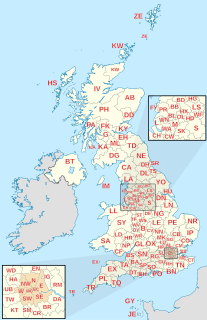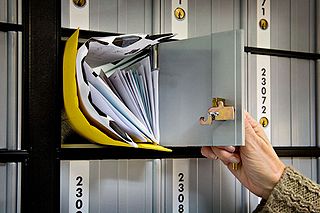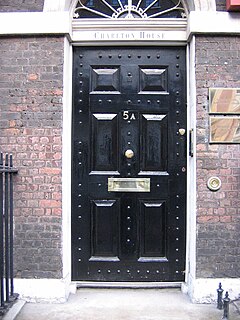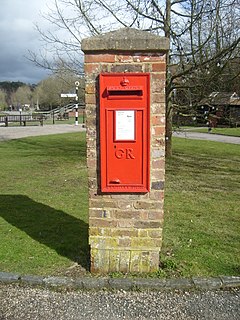
A post office is a public facility and a retailer that provides mail services, such as accepting letters and parcels, providing post office boxes, and selling postage stamps, packaging, and stationery. Post offices may offer additional services, which vary by country. These include providing and accepting government forms, and processing government services and fees. The chief administrator of a post office is called a postmaster.

Postal codes used in the United Kingdom, British Overseas Territories and Crown Dependencies are known as postcodes. They are alphanumeric and were adopted nationally between 11 October 1959 and 1974, having been devised by the General Post Office. A full postcode is known as a "postcode unit" and designates an area with several addresses or a single major delivery point.

Arnold Machin O.B.E., R.A. was a British artist, sculptor, and coin and postage stamp designer.

Royal Mail plc is a British multinational postal service and courier company, originally established in 1516 as a government department. The company's subsidiary Royal Mail Group Limited operates the brands Royal Mail and Parcelforce Worldwide (parcels). GLS Group, an international logistics company, is a wholly owned subsidiary of Royal Mail Group. The group used the name Consignia for a brief period in the early 2000s.

Stirlingshire or the County of Stirling, Scottish Gaelic: Siorrachd Sruighlea) is a historic county and registration county of Scotland. Its county town is Stirling.

A post office box is a uniquely addressable lockable box located on the premises of a post office.

A letter box, letterbox, letter plate, letter hole, mail slot or mailbox is a receptacle for receiving incoming mail at a private residence or business. For outgoing mail, Post boxes are often used for depositing the mail for collection, although some letter boxes are also capable of holding outgoing mail for a carrier to pick up. Letterboxes or mailboxes use the following primary designs:

Hongkong Post is a government department of Hong Kong responsible for postal services, though operated as a trading fund. Founded in 1841, it was known as Postal Department or Post Office before the handover of Hong Kong in 1997. It has been a sub-member of the Universal Postal Union since 1877, and is a separate entity from China Post.

A post box, also known as a collection box, mailbox, letter box or drop box is a physical box into which members of the public can deposit outgoing mail intended for collection by the agents of a country's postal service. The term post box can also refer to a private letter box for incoming mail.

A pillar box is a type of free-standing post box. They are found in the United Kingdom and British overseas territories, and, less commonly, in many members of the Commonwealth of Nations such as Cyprus, India, Gibraltar, Hong Kong, Malta, New Zealand and Sri Lanka, as well as in the Republic of Ireland. Pillar boxes were provided in territories administered by the United Kingdom, such as Mandatory Palestine, and territories with agency postal services provided by the British Post Office such as Bahrain, Dubai, Kuwait and Morocco. The United Kingdom also exported pillar boxes to countries that ran their own postal services, such as Argentina, Portugal and Uruguay.

Wall boxes are a type of post box or letter box found in many countries including France, the United Kingdom, the Commonwealth of Nations, Crown dependencies and Ireland. They differ from pillar boxes in that, instead of being a free-standing structure, they are generally set into a wall or supported on a free-standing pole, girder or other stable structure.

The Crown of Scotland is the crown that was used at the coronation of the monarchs of Scotland. Remade in its current form for King James V of Scotland in 1540, the crown is part of the Honours of Scotland, the oldest surviving set of Crown jewels in the British Isles. The crown dates from at least 1503 when, in an earlier form, it was depicted in the portrait of King James IV in the Book of Hours commissioned for his marriage to Margaret Tudor.

In modern heraldry, a royal cypher is a monogram or monogram-like device of a country's reigning sovereign, typically consisting of the initials of the monarch's name and title, sometimes interwoven and often surmounted by a crown. Such a cypher as used by an emperor or empress is called an imperial cypher. In the system used by various Commonwealth realms, the title is abbreviated as 'R' for 'rex' or 'regina'. Previously, 'I' stood for 'imperator' or 'imperatrix' of the Indian Empire.

The Carron Company was an ironworks established in 1759 on the banks of the River Carron near Falkirk, in Stirlingshire, Scotland. After initial problems, the company was at the forefront of the Industrial Revolution in the United Kingdom. The company prospered through its development and production of a new short-range and short-barrelled naval cannon, the carronade. The company was one of the largest iron works in Europe through the 19th century. After 223 years, the company became insolvent in 1982 and was later acquired by the Franke Corporation, being rebranded Carron Phoenix.

The Pillar Box War refers to a number of politically motivated acts of vandalism against post boxes in Scotland during the early 1950s in a dispute over the correct title of the new British monarch, Elizabeth II or Elizabeth I.

In the UK, a Ludlow wall box is a post box where mail is deposited to be collected by the Royal Mail. They are built into stone pillars or the walls of buildings and are never found free-standing. This is because they are made largely from wood. They were nearly all made by the now-defunct company of James Ludlow & Son of Birmingham, whose name they take. Similar designs exist as historical artefacts in certain Commonwealth countries. Ludlow style boxes have been in use since 1885 and were in continuous manufacture until 1965.

The Royal Gibraltar Post Office is the postal services in the British overseas territory of Gibraltar. It is currently a department within the Government of Gibraltar.

Arthur's O'on was a stone building thought to be Roman temple that, until 1743, stood on rising ground above the north bank of the River Carron not far from the old Carron ironworks in Stenhousemuir, near Falkirk, Scotland. The structure is thought to be the 'stone house' which gave its name to Stenhousemuir. Early historians discussed historical and mythical associations with the site and by 1200 the estate of Stenhouse on which it stood had been named after it.

To commemorate British gold medal winners at the 2012 Summer Olympics and 2012 Summer Paralympics, various post boxes in the home towns of the medal winners around the United Kingdom, plus one each on Sark and the Isle of Man, were repainted gold. It marked the first occasion in modern times that the colour of post boxes in the United Kingdom had been changed from their traditional red. Originally intended to be a temporary measure, due to the positive public response it was later decided the colour change would become a permanent tribute, with boxes additionally receiving their own special plaques.
Events from the year 1952 in Scotland.






























